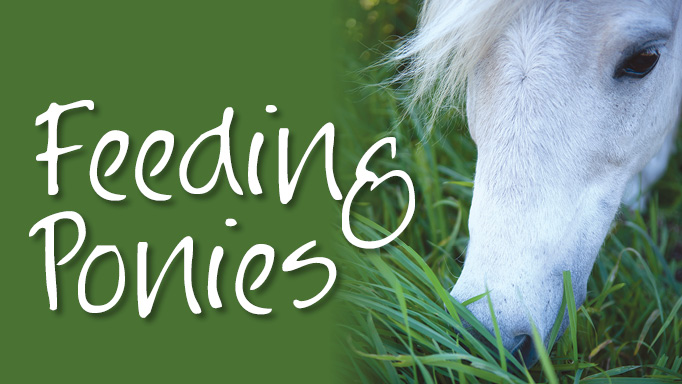Ponies are not just short horses; their breeding has made them hardy animals which can survive in harsh climates on lesser-quality feed. When we mix those bloodlines with today’s forages and concentrates, we see a large number of obese ponies that are at a significantly higher risk of laminitis. Ponies are more prone to obesity than horses, partly due to their easy-keeper metabolism, and partly because the public has a perception that ponies should be a little fatter (fat equals “cute”). This is a dangerous combination.
The National Research Council’s Nutrient Requirements of Horses (2007) does not list specific nutritional requirements for ponies, other than for accounting for lower body weight. For a 200-kg pony the NRC recommends 6.1, 6.7, or 7.3 mcal of digestible energy per day for ponies that tend to be easy keepers, average keepers, and harder keepers, respectively. However, Pearson and colleagues (British Journal of Nutrition, 2001) used an equation that would suggest a requirement of 5.9 mcal per day for a 200-kg pony. Regardless of what the calorie requirements may be, the best way to gauge energy balance is with body condition scoring ‒ if they get fat, they are consuming too many calories!
The Henneke body condition scoring method that uses the 1-9 rankings can be applied to ponies, noting that some pony breeds carry fat in slightly different areas than horses; for example, Connemaras tend to have crestier necks. It is also very important to note that most owners are not very good at body conditioning their own horses or ponies, and an outside, more objective opinion is often needed. It is critical that owners learn to keep their ponies at a body condition score below 6 on the scale to reduce the risk of laminitis and insulin resistance.
Calorie Counting
The key for feeding ponies is to monitor feed (and therefore calorie) intake based on maintaining a moderate (~5/9) body condition score. Because they tend to be easy keepers, this likely requires restricting hay to 1.25-1.5% of their body weight (less than the 1.5-2% or more recommended for horses), and only limited access to pasture via grazing muzzles. Hay analysis to select for lower starch and sugar hay (low non-structural carbohydrate) is also helpful to prevent insulin resistance. This can be a challenge, of course, since they also tend to be clever or greedy (see sidebar), and are often the loudest at feeding time. Appeasing them with a couple of timothy hay cubes or small amount of soaked beet pulp is a good trick. Depending on the quality of hay, they probably only need a vitamin-mineral supplement, but a small amount of a ration balancer might be needed if protein intake from the hay is too low.
Working ponies will have higher energy (calorie) requirements, but again, this can adjusted based on body condition score. If they do not consume enough hay to meet their energy needs, some small amounts of low-starch or senior concentrates may be warranted.
Pony broodmares will require extra attention to ensure they are not too fat. Ponies are at a higher risk of developing hyperlipidemia (high concentration of fats in the blood) when pregnant, which can be a life-threatening condition. Ponies can also develop this when stressed and/or are put on a severe diet, so don’t restrict your pony too much, too soon!
In one study looking at the effectiveness of grazing muzzles on pasture intake in ponies, ponies were put out to pasture for only three hours per day, with or without wearing a grazing muzzle. Those without the grazing muzzles quickly learned their time to eat was limited, and ate two-thirds of their daily calorie requirements in those three hours. Nom nom nom.

